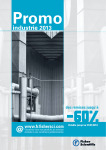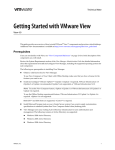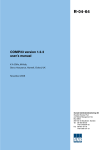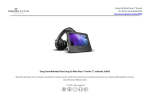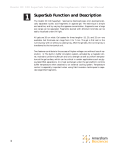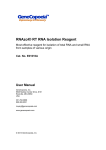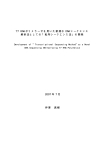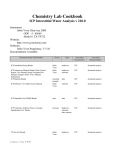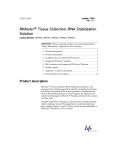Download RNaid® Kit - MP Biomedicals
Transcript
Instruction Manual RNaid® Kit Isolates and Purifies RNA from Agarose or Polyacrylamide Gels, from Solutions, and from Unincorporated Radioactive Label. › One Call 200 Preps › One Source › A World of Biotechnology Reagents Storage: Ambient (15 -30°C) Catalog # 1007-200 Revision # 1007-200-10OCT www.mpbio.com MP Biomedicals • 29525 Fountain Parkway • Solon, OH 44139 • tel: 1.800.854.0530 • fax: 1.800.334.6999 RNaid® Kit Lyse BIG and FAST with Interchangeable Adapters! CoolTeenPrep™ Adapter QuickPrep™ Adapter 6x15ml samples under cryogenic conditions 24 x 2 ml samples (included with FastPrep®-24 Instrument) CoolBigPrep™ Adapter TallPrep™ Adapter 2 x 50ml samples under cryogenic conditions 24 x 4.5ml samples CoolPrep™ Adapter TeenPrep™ Adapter 24 x 2 ml samples under temperaturecontrolled conditions 12 x 15ml samples HiPrep™ Adapter BigPrep™ Adapter 48 x 2ml samples 2 x 50 ml samples The FastPrep-24 instrument is delivered with the QuickPrep™ Adapter 2 www.mpbio.com RNaid® Kit Isolates and Purifies RNA from Agarose or Polyacrylamide Gels, from Solutions, and from Unincorporated Radioactive Label. 200 Preps Storage: Ambient (15 -30°C) Catalog # 1007-200 Revision # 1007-200-10OCT www.mpbio.com 3 RNaid® Kit TABLE OF CONTENTS 1. Introduction to the RNaid® Kit.............................................................. 5 2. Kit Components and User Supplied Materials....................................... 5 2.1 RNaid® Kit Components................................................................. 5 2.2 User Supplied Materials................................................................. 5 3. Important Considerations Before Use................................................... 6 4. Storage............................................................................................... 6 5. Safety Precautions............................................................................... 6 6. Protocol............................................................................................... 7 6.1 Isolation of RNA from Solutions, from Agarose or Polyacrylamide Gels Containing up to 6M Urea.............................. 7 6.2 Isolation of RNA from Agarose Gels Containing Formaldehyde.............................................................. 9 6.3 Purification of RNA from Transcription Reactions.......................... 10 7. Troubleshooting Guide....................................................................... 13 7.1 Gel Purification............................................................................ 13 7.2 Adsorption to RNAMATRIX®.......................................................... 14 7.3 Spectrophotometer Readings....................................................... 15 8. Recommended Reference Format for Publication............................... 16 9. Related Products............................................................................... 16 10. Product Use Limitation & Warranty..................................................... 17 4 www.mpbio.com 1. Introduction to the RNaid® Kit The RNaid® Kit contains all of the solutions and reagents, except for ethanol, necessary for the isolation and purification of RNA in twenty minutes from agarose and polyacrylamide gels, from solutions, and from unincorporated radioactive label (see Protocol). The resulting RNA is suitable as a substrate for multiple enzymatic manipulations including reverse transcription, RNase protection assays, and in vitro translation. For isolation of total RNA from tissues/cells use the RNaid® Plus Kit (Cat # 1109-200) or Total RNA SAFEKIT™ (Cat # 1008-200). For difficult to lyse samples use the FastRNA® Kits (visit www.mpbio.com for information). The RNaid® Kit provides sufficient reagents for two hundred or more RNA purifications. 2. Kit Components and User Supplied Materials 2.1 RNaid® Kit Components DEPC Treated Water RNA Binding Salt RNA Wash Concentrate RNAMATRIX® 10% Acetic Acid User manual MSDS (Online: www.mpbio.com) Certificate of Analysis 15 ml 60 ml 120 ml 1.5 ml 0.5 ml 1 each 1 each 1 each 2.2 User Supplied Materials Microcentrifuge that can freely spin 2.0 ml tubes Microcentrifuge tubes (2.0 ml and 1.5 ml) Rotator or low-speed vortex Gel Electrophoresis Apparatus Power Source Sterile water TAE Buffer 100% Ethanol www.mpbio.com 5 RNaid® Kit Note: The User Supplied Materials below are necessary dependent upon your experimental approach. See protocols below for more information. Citric acid 8M Urea Formamide MOPS EDTA NaOAc Formaldehyde Ethidium bromide Transcription Reaction Kit 3. Important Considerations Before Use The RNaid® Kit and all of its reagents are for research use only. All kit components have been lot qualified for the isolation of undegraded RNA. To avoid contamination of samples and reagents with RNase, follow appropriate laboratory procedures, wear surgical or similar gloves, use sterile vials, pipets, and pipet tips etc. To prepare glass, ceramic, or metal homogenizers, clean and bake at 200°C for 2 hours to remove any contaminating RNase. The RNaid® Kit contains RNA Wash Concentrate (1007-203). This component needs to be prepared before use in the protocol. Add 120 ml of 100% Ethanol to the bottle of RNA Wash Concentrate and mix well before use. 4. Storage The RNaid® Kit is shipped at ambient temperature. Recommended storage is at ambient temperature. 5. Safety Precautions The RNaid® Kit contains components, RNA Binding Salt and 10% Acetic Acid, that when in contact with human tissue, may cause minor irritation. Wear personal protective 6 www.mpbio.com equipment to prevent contact with the skin or mucus membranes (gloves, lab coat, and eye protection). Consult the Material Safety Data Sheet at www.mpbio.com for additional details. 6. Protocol 6.1 Isolation of RNA from Solution, from Agarose or Polyacrylamide Gels Containing up to 6M Urea Note: Reagents for agarose/urea gels are not included with the kit. For an agarose gel in 0.5X TAE buffer containing up to 6M urea, prepare two solutions. Solution A 1. Dissolve 8M urea in water by heating to 60°C. 2. Cool to room temperature and adjust pH to 3.8 with solid citric acid. 3. Add approximately 0.8g citric acid/100 ml 8M urea; use free acid, not sodium salt. Solution B 1. Prepare a 4X agarose solution in 2X TAE buffer, pH 6.0. 2. Melt agarose completely by boiling. 3. Mix Solution A with 1/4 volume melted Solution B and cast gel. The final concentration is 6M urea and 0.5x TAE at the desired agarose concentration. The gel will solidify within 30 to 60 minutes at 4°C. An agarose concentration of less than 1% may take overnight at 4°C to solidify. The gel will remain clear upon solidification. 4. Load sample and run at 4°C. Heat denature RNA sample before loading by incubation at 60°C for 10 minutes in the presence of 50% formamide, or at 80°C for 10 minutes without formamide. Isolation of RNA from Solution 1. Add 3 volumes of RNA Binding Salt and mix well. 2. Continue with Step 3, below. Isolation of RNA from Agarose 1. Excise desired RNA band from ethidium bromide stained gel and determine approximate volume by its weight (1 mg = 1 µl volume). Place gel slice in microcentrifuge tube. www.mpbio.com 7 RNaid® Kit 2. Add 3 volumes of RNA Binding Salt (i.e. to 0.1 g gel slice add 0.3 ml of RNA Binding Salt). Mix and incubate at room temperature for 10 minutes to dissolve agarose. Alternatively, place tube in 45-55°C water bath to dissolve agarose more rapidly. Continue with Step 3, below. Isolation of RNA from Polyacrylamide 1. Excise band from ethidium bromide stained gel and determine approximate volume by weight. Place into microcentrifuge vial. If the gel concentration is 10% or greater, then crush or cut the gel into small pieces. Add 3 volumes of RNA Binding Salt. Soak for 20 minutes at 60°C. Remove liquid with small bore pipet tip avoiding gel pieces, and transfer to new vial. 2. Add 2 µl of 10% Acetic Acid per every 0.5 ml of liquid to change pH to 5.0-5.5 (check with pH paper). This will increase recovery efficiency. 3. Estimate the amount of RNA expected and add 1 µl of RNAMATRIX® for every µg of RNA. Add a minimum of 5 µl of RNAMATRIX®. Mix well and allow binding of RNA to the matrix for at least 5 minutes at room temperature. Mix occasionally to keep RNAMATRIX® in suspension during adsorption. 4. Spin for 1 minute in microcentrifuge at maximum speed to pellet RNA/RNAMATRIX® complex. Remove supernatant and save aside; if supernatant contains residual RNA, more RNAMATRIX® can be added for complete recovery. Spin pellet again briefly and remove residual liquid with small bore pipet tip. 5. Add 500 µl RNA Wash solution (remember to add ethanol before first use; see Section 3, above) and resuspend pellet by mixing with pipet tip. Spin for 1 minute in microcentrifuge at maximum speed and remove supernatant. 6. Repeat washing Step 5 at least 1-2 times. After last wash, spin tube again briefly and remove residual liquid with small bore pipet tip. 7. Resuspend pellet in RNase-free water (use kit-supplied DEPC Treated Water). Use 10-20 µl per 5 µl RNAMATRIX®. Mix thoroughly with pipet tip and elute RNA by incubating at 45-55°C for 5 minutes. 8. Spin for 2 minutes in microcentrifuge at maximum speed. The RNA will be in the supernatant. Remove supernatant containing RNA to sterile vial. Note: Before spectrophotometric analysis of the sample, spin tube for 1 minute to pellet any remaining RNAMATRIX® material, and remove RNA sample to new vial. Alternatively, pass RNA sample through a sterile 0.2 µm membrane syringe filter attached to a syringe, or in a spin column. 9. Optional: Repeat elution Steps 7 and 8 to recover an additional 5-15% RNA. 8 www.mpbio.com 6.2 Isolation of RNA from Agarose Gels Containing Formaldehyde Note: Reagents for agarose/formaldehyde gels are not included with the kit. 10x Gel Buffer: 200 mM MOPS, pH 7.0 (adjust with NaOH) 10 mM EDTA 10 mM NaOAc. Prepare 1.2% agarose gel containing 6.6% formaldehyde and 1X gel buffer. Do not add ethidium bromide to the gel, only to the RNA sample as described below. Run gel at 3-5 V/cm in 1X gel buffer with 6.6% formaldehyde at pH 7.0. Preparation of RNA sample for gel: 10 µl formamide (deionized) 4 µl formaldehyde (37%/12.3 M) 2 µl 10x gel buffer 3 µl RNA (up to 20 µg) 1 µl ethidium bromide (400 µg/ml) Heat at 65°C for 10 minutes before loading in well of agarose gel. Formamide is dense enough to allow the sample to be loaded without adding an additional dense liquid; however, a loading dye mixture can be used if preferred. Isolation of RNA from Agarose/Formaldehyde Gel 1. Excise RNA band(s) from gel after electrophoresis. Visualize RNA with long wave UV for minimal length of time while cutting gel. Determine approximate volume of gel slice(s) by weight and place slice(s) into microcentrifuge tubes. 2. Adjust the pH of the RNA Binding Salt to pH 5.0 by adding 2 µl of 10% Acetic Acid (included with kit) per 1 ml of RNA Binding Salt and add 3 volumes to the gel slice (i.e. to 0.1 g gel slice add 0.3 ml Binding Salt/Acetic Acid mixture). The lower pH will optimize the binding efficiency of RNA to the RNAMATRIX®. Incubate at 37°C for approximately 10 minutes with occasional mixing to melt agarose. 3. When gel is completely melted, place vial at room temperature and add 1-2 µl of RNAMATRIX® per µg of RNA (add a minimum of 5 µl of RNAMATRIX®). Mix well and allow RNA to adsorb to the matrix for 10 minutes at room temperature with periodic mixing. www.mpbio.com 9 RNaid® Kit 4. Centrifuge for 1 minute in microcentrifuge at maximum speed to pellet the RNA/ RNAMATRIX® complex. Remove supernatant to new tube and save for possible re-adsorption. Briefly spin again to collect remaining liquid in bottom of the tube. Remove all traces of liquid with a small bore pipet tip. 5. Resuspend pellet in same amount of RNA Binding Salt as in Step 2 to wash pellet and help remove remaining traces of agarose and formaldehyde. Mix thoroughly with pipet tip. Spin for 1 minute and remove supernatant. Pulse spin and remove traces of liquid with small bore pipet tip. 6. Resuspend pellet in 500 µl RNA Wash solution (remember to add ethanol before first use; see Section 3, above) by mixing with pipet tip. Spin for 1 minute and remove supernatant. 7. Repeat washing Step 6 at least 1-2 times. Re-spin and remove traces of liquid as described in Step 5. 8. Resuspend pellet completely in DEPC-Treated Water by mixing with pipet tip. Use 1020 µl of water per 5 µl RNAMATRIX®. Elute RNA by incubating at 80°C for 10 minutes. Spin tube for 2 minutes and remove supernatant with RNA. If using the SPIN Filter option, transfer suspension to a SPIN Filter and spin for 1 minute in microcentrifuge. The supernatant containing RNA will be in the catch tube. 9. Optional: A second elution will yield 5-15% more RNA. 10.Heat eluted RNA to 80°C for 10 minutes to further dissociate residual formaldehyde from RNA. This second heating step will reverse chemical modification of the RNA caused by formaldehyde (Boedtker, H., 1967, Biochemistry 6, 2718-2727) and will render RNA biologically active as substrate for modifying enzymes. Let cool to room temperature to allow RNA to renature, or place on ice immediately to avoid renaturing. The RNA is now ready for use in enzymatic manipulations. 6.3 Purification of RNA from Transcription Reactions Note: Reagents for transcription, template removal, and hydrolysis are not included with the kit. Transcription Reaction (Commercially available as a kit from several manufacturers) 1. Combine the following 5 µl 5x transcription buffer (200 mM Tris-HCl, pH 7.5 at 37°C, 30 mM MgCl2, 10 www.mpbio.com 2. 50 mM NaCl, 10 mM spermidine) 1 µl RNase Inhibitor (1 unit/µl) 1 µl 50 mM DTT 1 µl each rATP, rGTP, rUTP (10 mM each) 4 µl radioactively labeled rCTP (200 µCi) 8 µl distilled water 1 µl DNA template (1µg/µl) 1 µl RNA Polymerase (i.e. T3, T7, or Sp6 Polymerase) 25 µl total reaction volume Mix and incubate at 37°C for 1 hour. When completed, remove 1 µl of the reaction and determine TCA precipitable counts to calculate % incorporation. Removal of DNA Template and Hydrolysis of RNA Note: Depending on the size of the transcribed RNA and the purpose of use, it may be necessary to shorten the transcripts by hydrolysis with sodium hydroxide. After hydrolysis, it is crucial to neutralize the pH before purification of the RNA with RNAMATRIX®. If the pH of the sample is alkaline the RNA will not adsorb to the matrix. 3. Add 1 µl of RNase-free DNase (10 units/µl). Incubate at 37°C for 10 minutes and place on ice. If probe is to be hydrolyzed, continue with Step 4. Otherwise, skip ahead to Purification of RNA, Step 7, below. 4. Add 50 µl ETS buffer (10 mM Tris-HCl, pH 7.5, 1 mM EDTA, 0.1% SDS), 1.7 µl 5M NaCl, and 1 µl 1M DTT. Mix thoroughly. 5. Add 10 µl 2N NaOH for hydrolysis of RNA transcripts. Incubate on ice for 30 minutes for smaller transcripts (< 1kb) or for 60 minutes for larger transcripts (> 1 kb). As an example, a 1 kb transcript can be shortened to 150-220 bases by incubating 30-40 minutes at 4°C. 6. Warm to room temperature, then add 20 µl (2x volume) of 1 M MES buffer to neutralize pH and stop hydrolysis. Add MES buffer after warming tube to room temperature to prevent precipitation. Volume is approximately 110 µl at this point. www.mpbio.com 11 RNaid® Kit Purification of RNA with RNAMATRIX® 7. Add 3 volumes of RNA Binding Salt and mix. Do not precipitate or gel purify RNA prior to adding RNA Binding Salt and RNAMATRIX®. Pre-purifying the “hot” RNA can lead to very tight binding to the RNAMATRIX® and will be difficult to elute. 8. Estimate the amount of transcripts and add 1-2 µl of RNAMATRIX® per µg of RNA; add a minimum of 5 µl of RNAMATRIX®. Mix well and incubate at room temperature for 5 minutes with occasional mixing to allow adsorption of RNA to the matrix. 9. Spin for 1 minute in microcentrifuge at maximum speed and remove and discard supernatant which contains most of the unincorporated label. Follow precautions and regulations for handling and disposing of radioactive materials as specified in Radioactive Materials License. 10.Wash pellet two times with 500 µl RNA Wash Solution (remember to add the correct amount of ethanol before first use, see section 3 for instructions) and resuspend pellet completely by mixing with pipet tip. Spin for 1 minute in microcentrifuge at maximum speed and remove supernatant. 11.Remove residual traces of liquid and elute RNA with appropriate volume of DEPCTreated Water by carefully resuspending pellet and incubating at 500C for 3 minutes. Spin for 1 minute and remove supernatant containing labeled RNA to new tube. If using the SPIN™ option, transfer suspension to a SPIN™ Filter and spin for 1 minute in microcentrifuge. The supernatant containing RNA will be in the catch tube. 12.Optional: A second elution will yield 5-15% more RNA. Note: If the RNAMATRIX® retains radioactive label, elute a second time by resuspending pellet in RNase-free water and incubating at 80°C for 3 minutes. Spin and remove supernatant to new tube. If the second elution does not contain any radioactive label and the RNAMATRIX® still retains radioactivity, all RNA has been eluted. Radioactivity retained by the RNAMATRIX® represents reagent decay products which bind to the RNAMATRIX®. If available, use fresh radioactive reagents no older than two weeks from the date of manufacture since the amount of decay products increases with age of radioactive materials (especially 32P-labelled reagents). It is important to purify radioactively labeled RNA using the RNaid® Kit with SPIN™ immediately after transcription reaction is complete to minimize binding of RNA radiolysis products to the RNAMATRIX®. 12 www.mpbio.com 7. Trouble Shooting Guide 7.1 Gel Purification Technical Background: The right choice of gel separation system is extremely important for best results. Criteria are native versus denaturing conditions and agarose versus polyacrylamide gel matrix. Generally, recovery of RNA from agarose gels is more efficient and convenient than from polyacrylamide. However, separation properties of polyacrylamide are usually superior. To improve recovery efficiency from polyacrylamide, extract RNA at elevated temperature (5565°C) and extended time (20 min). Both formaldehyde and agarose gels as well as TBE/ polyacrylamide gels create unfavorable binding conditions for RNA to RNAMATRIX® as the pH increases upon dissociation of the gel. Adjustment to more acidic conditions is necessary. In both cases, optimal binding efficiency can be restored by adjusting the pH to an appropriate range using 10% acetic acid (kit-supplied). When using formaldehyde, do not exceed a final concentration of 6.6% in the gel and buffer, and prepare all solutions fresh just before use. Avoid adding ethidium bromide to the formaldehyde gel since it will fluoresce and render the detection of RNA bands extremely difficult. Instead, add ethidium bromide to the RNA sample before loading as described in Section 7.3, below. Always remember to process RNA as quickly as possible, never leave RNA inside gel for long periods of time (> 1hr), remove immediately and store under proper conditions to avoid degradation. Important Note: Agarose or acrylamide used for separation of RNA should be of highest purity available. The quality of chemicals used for gel buffers is equally critical for good separation results. When preparing urea solutions, always filter-purify through 0.45 µm membrane to remove insoluble particles. Pre-treat hardware, such as glassware, gel devices, combs, spacers, etc., with RNase Erase to remove contaminating RNases. Use sterile, individually wrapped and unopened disposable supplies if possible. Prepare all buffers and gels with DEPC-Treated Water and autoclaved buffers. Problem: Agarose gel slice does not dissolve completely. Solution: Follow instructions and incubate agarose at 45-55°C for 10 minutes. If gel has not dissociated, add more RNA Binding Salt and continue incubation at same temperature for 10 minutes. www.mpbio.com 13 RNaid® Kit Problem: Liquid cannot be completely removed from polyacrylamide gel elution, or transferred liquid contain small pieces of polyacrylamide. Solution: Remove gel pieces by forcing liquid trough a 0.2 µm membrane attached to a syringe (Acrodisc PF with 0.2 µm Supor and 0.8 µm Pre-filter works well, supplied sterile by Gelman Sciences). Alternatively, use a large pipet tip with a sterile cotton plug. Do not use glass wool. Problem: The RNA solution eluted from the gel has been checked with pH paper and shows a pH>7.5. Solution: Use the kit-supplied 10% Acetic Acid to adjust pH. Add 2 µl 10% Acetic Acid per every 0.5 ml of eluted liquid to change pH to 5.0-6.0 and check with pH paper. This procedure should be used for both TBE/polyacrylamide and formaldehyde/agarose eluents. Once pH has been adjusted to optimal range, continue with RNA purification and add RNAMATRIX® to the eluted RNA. 7.2 Adsorption to RNAMATRIX® Technical Background: The conditions for binding of RNA to the RNAMATRIX® can be varied according to lysis and/or purification method (see Gel Purification section) and desired RNA population or size of RNA molecules. The binding efficiency is influenced by ionic strength and pH. Adsorption in the presence of guanidine thiocyanate only (lysis solution) selects for larger RNA’s. Addition of RNA Binding Salt during adsorption causes binding of smaller molecules. Optimal pH range for adsorption of RNA to RNAMATRIX® is Ph 5.5-7.5; higher pH conditions result in a loss of binding capacity. In general, lower pH (5.5-6.0) tends to increase binding of smaller RNA molecules; slightly higher pH (6.5-75) favors larger sizes. Problem: After addition of RNAMATRIX® and mixing, the matrix forms aggregates and does not disperse evenly throughout the sample. Solution: Aggregation of the RNAMATRIX® tends to occur at high concentrations of nucleic acid. Try breaking up aggregates with pipet tip or by rocking tube back and forth quickly. Small aggregates will not effect the procedure. Problem: During RNA wash steps of the pellet, the RNAMATRIX® does not disperse evenly. Solution: The pellet is as easily dispersed in the RNA Wash solution (containing ethanol) as in water. When adding the RNA Wash solution to the pellet, use same pipet tip and 14 www.mpbio.com break-up pellet by stirring. Be careful to expel any trapped matrix from the tip back into the sample. Small aggregates will not affect the procedure. Problem: During adsorption to RNAMATRIX®, not all RNA is bound and removed from solution. Solution: The amount of RNAMATRIX® was not sufficient to adsorb all of the RNA. Transfer supernatant with unbound RNA to new vial, add 5-10 µl of new RNAMATRIX®. You may also re-use the matrix previously applied to this sample. Save supernatant until after the initially bound RNA is eluted from the matrix, then add supernatant back to the same matrix. Incubate, and follow wash procedures as described. Elute RNA with 5-10 µl DEPC-Treated Water and combine with RNA eluted from the first adsorption process. 7.3 Spectrophotometer Readings Technical Background: The amount of nucleic acid in the eluent from RNAMATRIX® can be determined by optical density at 260 nm. The RNAMATRIX® material absorbs over a wide range of the spectrum, including UV. This absorption is consistent and very low over a range from 210 nm to approximately 310 nm, absorbing 0.01 OD units. Residual matrix material can easily be removed by centrifugation and this will not contribute to any absorption readings. Problem: OD260 measurement of the RNA Wash Solution supernatant shows UV absorption. Solution: Spin vial with pellet of RNA/RNAMATRIX® complex for 10 seconds and remove traces of liquid with a small bore pipet tip. Resuspend pellet in 500 µl RNA Wash Solution and mix with pipet tip to resuspend the matrix evenly. Spin for 1 minute in microcentrifuge at maximum speed. Remove supernatant and measure OD260. If absorption is still above background, repeat washing procedure. If no absorption is detectable, proceed with elution of the RNA as described. Problem: Eluted RNA is contaminated with residual RNAMATRIX®. Solution: Small amounts of RNAMATRIX® in the RNA sample are inert and will not effect enzymatic reactions. However, RNAMATRIX® absorbs UV light and might effect OD260/280 measurements. To remove residual RNAMATRIX® from the eluted RNA, re-spin vial in microcentrifuge for 30 seconds at maximum speed and remove RNA solution with small bore pipet tip. Be careful not to touch bottom of tube near pellet www.mpbio.com 15 RNaid® Kit area. For consistent and reliable measurement of multiple samples, complete removal of residual RNAMATRIX® particles can be accomplished by centrifugal filtration through a SPIN™ Filter unit, or by passing RNA sample through a sterile 0.2 µm membrane attached to a syringe. 8. Recommended Reference Format for Publications RNA was isolated from (specific sample) using the RNaid® Kit (MP Biomedicals, Santa Ana, CA). 9. Related Products Description Size FastPrep® 24 Instrument FastPrep® Instrument FastPrep® FP120A Instrument FastPrep® FP220A Instrument FastDNA® Kit FastDNA® SPIN Kit FastDNA® SPIN Kit for Soil FastDNA® 50ml SPIN Kit for Soil FastRNA® Pro Soil-Direct Kit FastRNA® Pro Soil-Indirect Kit FastRNA® Pro Red Kit (Yeast & Fungus) FastRNA® Pro Green Kit (Plant & Animal) FastRNA® Pro Blue Kit (Bacteria) FastProtein™ Blue Matrix FastProtein™ Red Matrix Lysing Matrix E Lysing Matrix E Lysing Matrix E 16 100-230V 100V 120V 220V 100 preps 100 preps 50 preps 10 preps 50 preps 50 preps 50 preps 50 preps 50 preps 50 preps 50 preps 50 x 2 ml tubes 100 x 2 ml tubes 500 x 2 ml tubes www.mpbio.com Catalog # 6004-500 6001-100 6001-120 6001-220 6540-400 6540-600 6560-200 6570-200 6070-050 6075-050 6035-050 6045-050 6025-050 6550-400 6550-600 6914-050 6914-100 6914-500 10. Product Use Limitation & Warranty The products presented in this instruction manual are for research or manufacturing use only. They are not to be used as drugs or medical devices in order to diagnose, cure, mitigate, treat or prevent diseases in humans or animals, either as part of an accepted course of therapy or in experimental clinical investigation. These products are not to be used as food, food additives or general household items. Purchase of MP Biomedicals products does not grant rights to reproduce, modify, or repackage the products or any derivative thereof to third parties. MP Biomedicals makes no warranty of any kind, expressed or implied, including merchantability or fitness for any particular purpose, except that the products sold will meet our specifications at the time of delivery. Buyer’s exclusive remedy and the sole liability of MP Biomedicals hereunder shall be limited to, at our discretion, no replacement or compensation, product credits, refund of the purchase price of, or the replacement of materials that do not meet our specification. By acceptance of the product, Buyer indemnifies and holds MP Biomedicals harmless against, and assumes all liability for, the consequence of its use or misuse by the Buyer, its employees or others, including, but not limited to, the cost of handling. Said refund or replacement is conditioned on Buyer notifying within thirty (30) days of receipt of product. Failure of Buyer to give said notice within thirty (30) days shall constitute a waiver by the Buyer of all claims hereunder with respect to said material(s). FastDNA®, FastRNA®, FastPrep®, QBiogene®, and BIO 101® Systems are registered trademarks of MP Biomedicals, LLC. www.mpbio.com 17 RNaid® Kit Take Advantage of FastPrep® Kits Ready-to-use Protocols For DNA, RNA And Protein Isolation From Any Sample • Rapid and reproducible sample lysis and purification process • No cross contamination with the closed lysing matrix tubes • Increased yields of high quality DNA, RNA and proteins • Integrity and size of DNA, RNA and proteins are retained • Nucleic acids and proteins are ready-to-use in downstream application DNA PROTEIN FastPrep® Kits RNA FastDNA® Kit and FastDNA® Spin Kit Cat N° 6540-400 - Cat N° 6540-600 respectively (100 preps) • Lyse and isolate DNA in less than 30 minutes • Plant, animal, yeast, fungal and microbial samples • No hazardous organic reagents required • SPIN filters streamline silica handling (FastDNA Spin Kit) FastDNA® Spin Kit for Soil Cat N° 6560-200 (100 preps) • Lyse and isolate DNA in less than 30 minutes • Variety of soil and environmental sample types • No hazardous organic reagents required • SPIN filters streamline silica handling 18 www.mpbio.com FastRNA® Pro Blue Kitt Cat N° 6025-050 (50 preps) • For use with gram positive and gram negative bacteria • Lyse up to 1010 cells per 2ml tube • Lysis and isolation with single-phase organic solution in less than 90 minutes FastRNA® Pro Red Kit Cat N° 6035-050 (50 preps) • For use with yeast cells and fungal tissue • Lyse up to 1010 cells per 2ml tube • Lysis and isolation with single-phase organic solution in less than 90 minutes FastRNA® Pro Green Kit Cat N° 6045-050 (50 preps) • For use with all plant and animal samples • Lyse 50-100 mg tissue per 2ml tube • Lysis and isolation with single-phase organic solution in less than 90 minutes FastRNA® Pro Soil-Direct Kit and FastRNA® Pro Soil-Indirect Kit Cat N° 6070-050 - Cat N° 6075-050 respectively (50 preps) • Isolate RNA from soil samples (direct kit) and washed soil (indirect kit) in less than 2 hours • Variety of soil and environmental sample types • RNA protected during and after processing • Humic acids reduced to allow uninhibited RT-PCR • Includes additional reagents for even further purification if necessary • SPIN filters streamline silica handling FastProtein™ Blue Matrix Cat N° 6550-400 (50 preps) - Cat N° 6550-500 (100 preps) • Release of proteins from gram positive and gram negative bacteria in 40 seconds • Protein extracts are ready for immediate electrophoresis or purification • Ideal for optimizing induction conditions FastProtein™ Red Matrix Cat N° 6550-600 (50 preps) - Cat N° 6550-700 (100 preps) • Release of proteins from yeast cells and fungi in 40 seconds • Protein extracts are ready for immediate electrophoresis or purification • Ideal for optimizing induction conditions www.mpbio.com 19 Instruction Manual RNaid® Kit Revision # 1007-200-10OCT Worldwide Ordering and Technical Support United States of America Worldwide Headquarters Tel: +1.440.337.1200 Toll Free Tel: 800.854.0530 Fax: +1.440.337.1180 Toll Free Fax: 800.334.6999 Europe Toll Free Phone: 00800.7777.9999 Toll Free Fax: 00800.6666.8888 Australia MP Biomedicals Australasia Pty Ltd Tel: +61.2.9838.7422 Fax: +61.2.9838.7390 Belgium MP Biomedicals Tel: 02 466 00 00 Fax: 02 466 26 42 Canada MP Biomedicals Canada Tel: 888.362.5487 Fax: 514.935.7541 France MP Biomedicals France Tel: 03 88 67 54 25 Fax: 03 88 67 19 45 Serbia MP Global d.o.o. Tel: +381.11.2622.945 Fax: +381.11.2623.373 Germany MP Biomedicals Phone: 0800 426 67337 Fax: 0800 629 67337 Singapore MP Biomedicals Singapore Tel: 65.6775.0008 Fax: 65.6775.4536 Japan MP Bio Japan K.K. Tel: 03-3808-2102 Toll Free Tel: 0120.788.020 Fax: 03-3808-2401 The Netherlands MP Biomedicals Netherlands Tel: 0800-0227416 Fax: 0800-0227489 Switzerland MP Biomedicals Switzerland Tel: 061 271 0007 Fax: 061 271 0084 United Kingdom MP Biomedicals UK Tel: 0800 282 474 Fax: 0800 614 735 Poland MP Biomedicals Poland Tel: +48.22.659.58.95 Fax: +48.22.658.45.05 www.mpbio.com MP Biomedicals • 29525 Fountain Parkway • Solon, OH 44139 • tel: 1.800.854.0530 • fax: 1.800.334.6999




















